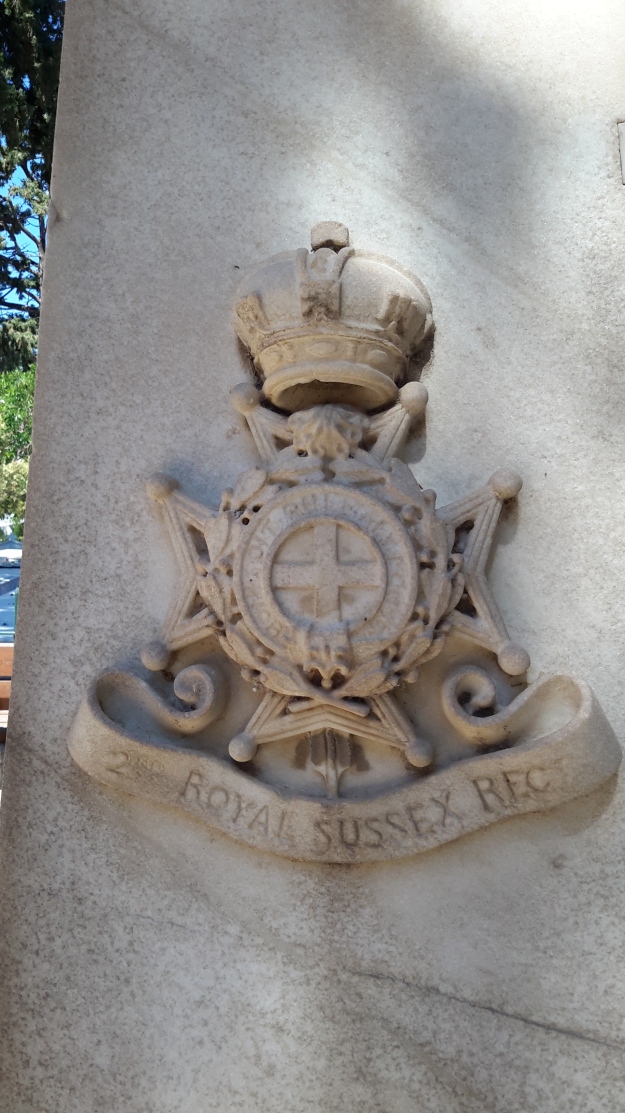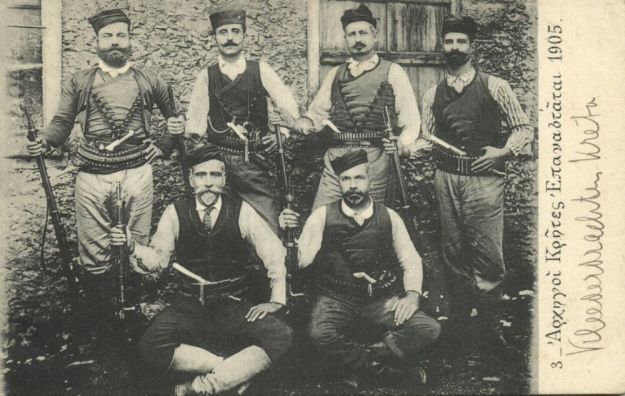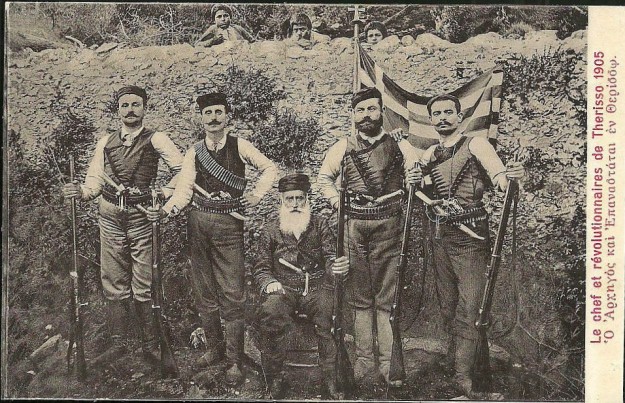Much of the information used in these Blogs comes from official sources; mostly British. These reflect the official view, usually from British officers, of what they considered was happening in Crete at that time, and what they considered worth reporting. These original sources would then have been archived, and what is now accessible in those archives is what some archivist considered worth keeping. Relatively few sources remain which express the views of the ordinary British troops. However, on occasion, the voice of the ordinary British soldier or sailor is discernible. Not usually in the official archives, but more often in the form their writings for their comrades in unofficial journals, or in letters and postcards sent home to their loved ones.
Purely by coincidence, the two such letters below were written by soldiers from 1/Northumberland Fusiliers. (Spelling and punctuation as in the original letters.)
Private W. West. C Co. 1/Northumberland Fusiliers.[1]
Letter to his sister and brother. Undated, but between 6th October and 5th November 1898. West had been through the Sudan Campaign and fought at Khartoum and Omdurman.
“We left Egypt on the 3rd October for Crete and arrived on the 6th same month with only a short sail and this place is not a very nice place. We are under canvas here doing duty with the Turks this time and it is a murderous place to bide in, you’re not safe. Before we came they came and killed a lot of people and some British soldiers and sailors which landed from the boat for there is a lot of battleships here and we are confined to barracks and not allowed to go out of town. We bide in our tent all the time. If a man has to go on duty he has to have an escort of armed men. If we go to bathe we have to take our rifles with us. It is a very big place Candia in Crete and we want to get the Turks out and if they do not go very soon our gunboats are going to blow the place up. The murderers have killed a lot.
We all had to land in small boats from our navy and it was awfully rough as there is no harbour here I suppose Jimmy has often passed it. We are camped right along-side the sea and it is very cold in the night here after coming from a hot place, the Sudan. We are only allowed 1 pint of beer a day, the men cannot get no more3, so the sooner we get away from here the better, but I think we will have another battle before we go, that will mean another medal then I will have a breast like a second-hand pawn shop, then I will be able to cut the death with my medals and my badges and cross gun, what, there are no flies on me, but I think they can keep the medal if only I get away.
When we were in the Sudan we got the order for Malta. We all got ready for it but they shoved us here instead. Hard luck coming out of one battle and going into another one. We’ll I’ll chance it anyway, see what god sends me. I suppose you have read about this affair, the Turks and the Armenians cutting up business, but they will get cutting up this time if they start, they will get what the Dervishes got and what Jimmy said, we’ll give them cold steel, and we did. What, there are no flies on me.”
Private W. West. C Co. 1/Northumberland Fusiliers[2]
Letter to his sister and brother. 5th February 1899.
“I tell you that Crete is a very bad place indeed for a soldier and I wish I was out of it really. But I tell you I am going to the West Indies in September.”
The following is a letter home from Private Michael Fitzgerald 1/Northumberland Fusiliers, reproduced here by kind permission of his great nephew, Patrick Fitzgerald.
‘Candia Crete January 8th 1899
My Dear Brother
I arrived here on 11th off the last month with the Detachment from Malta, all of the men that were able to pass the Doctor was sent here, it took us two days, It is one of the worst places I have ever been in there are two Regiments here our & the Rifle Brigade our Regiment is scattered all over the shop, there are two Companys away up the hills on outpost duty keeping the greeks and turks from fighting with one another I expect you know all about the row they had here last September, the Bashi Bazouk are a fierce looking lot but they are disarming them every day they have already about 30,000 Rifles off them so there is not much fear of them breaking out again. It is just as cold here as in England at present all the hills are covered with snow it is a cruel place to send a Regt. To after been in such a hot climate as the Sudan there has been and awful lot of sickness among the troops the Rifle Brigade lost about 40 men & ours lost about 9 men all the Turkish troops have left the Island so there is sure to be peace among them now. Our Regiment expects to leave here in March for the West Indies. I am going to try and get out of it if I can I have seen enough of the world, I wrote to you from Malta before I left and I have not got an answer yet I hope there is nothing up but id you wrote it might have gone astray as I have known a lot of men send curios and things from here and they never got an answer. I am going to send 10 shilling to you for Father you can send it two him you can’t get a postal order here so I an going to send it to you and you will know how to get it cashed for him. I am going to write to him to day I hope he is going on well. I haven’t heard from Polly or Maggie or Ellie this long time. I am going to send you a few little things at the end of this month so you can expect them, there has been more honours among out Officers & Non Coms than among any other Regiment & their is not a thing in the papers about them You would think that there was no other Regiment in the Soudan but the Guards & the Highlanders there Our Regt. Just done the same but we are not favourites with the papers but never mind we are just as much thought about so no more at present from
Your fond Brother Michael Fitzgerald
hoping that you may have good look & very good year write soon’
Michael Fitzgerald was born in Tourtane Lodge, beside the Duke of Devonshire’s estate at Lismore in Co. Waterford on the 26th July 1868. His father born in 1825 had served in the British Army but was receiving an army pension at the time of Michael’s birth.
Michael enlisted on the 17th November 1883 at Clonmel Barracks, stating his age to be 15 years and six months. He was assigned to the Northumberland Fusiliers Regiment with 501 as his service number, and saw service abroad in India, Gibraltar, Egypt, Malta & Crete according to his Account Book. He started as a Drummer and only reverted to Private on 1st September 1897.
Although the 2/Northumberland Fusiliers arrived on Crete on 6th October 1898, family records indicate that Michael arrived on Crete on the 10th December 1898. A previous researcher came up with was a record of him as dying in Candia on 29th March 1899, although Michael’s great nephew understands his date of death to be 19th April 1899.
As to the cause of his death, out of 12 servicemen who died on Crete in 1899 and whose cause of death is known, two died of enteric fever, two of alcohol poisoning, and one of malaria. The cause of death for the rest is unobtainable.
Assuming Michael was a Catholic, there’s a chance he was buried in the small Catholic graveyard in Candia (Iraklion). However, the records of burials here are sketchy to say the very least, basically just a few notes made by a researcher in the late 1980s, and the graveyard has since been built over and the memorials all dumped. There appears to be no memorial on Crete commemorating Michael. He was too late arriving on the island to appear on the memorial in Suda Bay; the Catholic graveyard no longer exists, and his name doesn’t appear on the current memorial wall or on any of the Northumberland Fusilier memorials in Iraklion.
As well as letters, servicemen sent souvenir postcards home.
‘Dear Sarah this is one of the main Streets so there is no fear of getting mixed up with the tramcars here I couldn’t get any of the ones I wanted but this will give you an idea of the town…..it looks better here than it is’ Undated from an unknown serviceman.
While British Army personnel were withdrawn from Crete in July 1909, the Royal Navy had a presence on the island until 1913.
‘HMS Minerva
Suda Bay
March 1st 1910.
Dear Old Tich
Papers to hand received quite safe and sound hope all at home are quite well as I am at present I am playing football today against the French Xi they are pretty hot at (Hocky?) I am sending usual money this is how we go ashore now all in white So Au Revoir
From your trusty brother NOBBY’
The following two postcards were apparently written by the same person, probably Tom Burnett.
Stamped at British Headquarters 29 September 1905.
‘This is prince george’s wife.
Dear Mother
Just a few lines hoping you are well as it leaves me so at present Tom’
Stamped at British Headquarters 28 December 1905.
‘Dear mother
I will (write?) later but a line hoping to find you are all quite well as it leaves me at present. I am busy now so will write later Tom’
Tom possibly served with 1/Kings Royal Rifle Corps who were on Crete from March 1905 to February 1906, or with 2/Royal Sussex who were on the island from May 1905 to February 1907. Other troops on the island at this time were a small number of Royal Engineers and 20 or so garrison staff.
[1] The Fusiliers Museum of Northumberland. ALFN:848
[2] Ibid.


























